Discovering Optimal Triplets for Assessing the Uncertainties of Satellite-Derived Evapotranspiration Products
Abstract
1. Introduction
2. Study Area and Datasets
2.1. Study Area
2.2. Datasets
2.2.1. Evapotranspiration Datasets
2.2.2. In-Situ Datasets
3. Methodology
3.1. Extended Triple Collocation
3.2. Experimental Design
3.2.1. Data Standardization
3.2.2. Cross-Correlation Analysis
3.2.3. Evaluation Indicators
3.2.4. Data Fusion
4. Results
4.1. Optimal Triplet Mining by Correlation Analysis
4.2. Spatial Distribution of the ETC-Estimated STD Errors of Six ET Products
4.3. Dataset Merging
5. Discussion
5.1. The Impacts of Seasonal Changes on TC Analysis
5.2. The Reliability of Triplet Ranking
5.3. The Issues of Identifying the Optimal Triplet
6. Conclusions
Author Contributions
Funding
Data Availability Statement
Acknowledgments
Conflicts of Interest
Abbreviations
| ET | Evapotranspiration |
| TC | Triple Collocation |
| ETC | Extended Triple Collocation |
| QC | Quadruple Collocation |
| MC | Multiple Collocation |
| STD | Standard Deviation |
References
- L’Vovich, M.I. Use and transformation of terrestrial water systems. In The Earth as Transformed by Human Action; TurnerII, B.L., Clark, W.C., Kates, R.W., Richards, J.F., Mathews, J.T., Meyer, W.B., Eds.; Cambridge University Press: Cambridge, UK, 1993; pp. 235–252. [Google Scholar]
- Lu, Z.; Zhao, Y.; Wei, Y.; Feng, Q.; Xie, J. Differences among Evapotranspiration Products Affect Water Resources and Ecosystem Management in an Australian Catchment. Remote Sens. 2019, 11, 958. [Google Scholar] [CrossRef]
- Jaafar, H.; Mourad, R.; Schull, M. A global 30-m ET model (HSEB) using harmonized Landsat and Sentinel-2, MODIS and VIIRS: Comparison to ECOSTRESS ET and LST. Remote Sens. Environ. 2022, 274, 112995. [Google Scholar] [CrossRef]
- Ochege, F.U.; Shi, H.; Li, C.; Ma, X.; Igboeli, E.E.; Luo, G. Assessing Satellite, Land Surface Model and Reanalysis Evapotranspiration Products in the Absence of In-Situ in Central Asia. Remote Sens. 2021, 13, 5148. [Google Scholar] [CrossRef]
- Khan, M.S.; Liaqat, U.W.; Baik, J.; Choi, M. Stand-alone uncertainty characterization of GLEAM, GLDAS and MOD16 evapotranspiration products using an extended triple collocation approach. Agric. For. Meteorol. 2018, 252, 256–268. [Google Scholar] [CrossRef]
- Stoffelen, A. Toward the true near-surface wind speed: Error modeling and calibration using triple collocation. J. Geophys. Res. Ocean. 1998, 103, 7755–7766. [Google Scholar] [CrossRef]
- McColl, K.A.; Vogelzang, J.; Konings, A.G.; Entekhabi, D.; Piles, M.; Stoffelen, A. Extended triple collocation: Estimating errors and correlation coefficients with respect to an unknown target: Extended triple collocation. Geophys. Res. Lett. 2014, 41, 6229–6236. [Google Scholar] [CrossRef]
- Chen, F.; Crow, W.T.; Bindlish, R.; Colliander, A.; Burgin, M.S.; Asanuma, J.; Aida, K. Global-scale Evaluation of SMAP, SMOS and ASCAT Soil Moisture Products using Triple Collocation. Remote Sens. Environ. 2018, 214, 1–13. [Google Scholar] [CrossRef] [PubMed]
- Pierdicca, N.; Fascetti, F.; Pulvirenti, L.; Crapolicchio, R. Error Characterization of Soil Moisture Satellite Products: Retrieving Error Cross-Correlation Through Extended Quadruple Collocation. IEEE J. Sel. Top. Appl. Earth Obs. Remote Sens. 2017, 10, 4522–4530. [Google Scholar] [CrossRef]
- Pierdicca, N.; Fascetti, F.; Pulvirenti, L.; Crapolicchio, R.; Munoz-Sabater, J. Quadruple Collocation Analysis for Soil Moisture Product Assessment. IEEE Geosci. Remote Sens. Lett. 2015, 12, 1595–1599. [Google Scholar] [CrossRef]
- Gruber, A.; Su, C.H.; Zwieback, S.; Crow, W.; Dorigo, W.; Wagner, W. Recent advances in (soil moisture) triple collocation analysis. Int. J. Appl. Earth Obs. Geoinf. 2016, 45, 200–211. [Google Scholar] [CrossRef]
- Pan, M.; Fisher, C.K.; Chaney, N.W.; Zhan, W.; Crow, W.T.; Aires, F.; Entekhabi, D.; Wood, E.F. Triple collocation: Beyond three estimates and separation of structural/non-structural errors. Remote Sens. Environ. 2015, 171, 299–310. [Google Scholar] [CrossRef]
- Kim, H.; Parinussa, R.; Konings, A.G.; Wagner, W.; Cosh, M.H.; Lakshmi, V.; Zohaib, M.; Choi, M. Global-scale assessment and combination of SMAP with ASCAT (active) and AMSR2 (passive) soil moisture products. Remote Sens. Environ. 2018, 204, 260–275. [Google Scholar] [CrossRef]
- Zhou, J.; Crow, W.T.; Wu, Z.; Dong, J.; He, H.; Feng, H. A triple collocation-based 2D soil moisture merging methodology considering spatial and temporal non-stationary errors. Remote Sens. Environ. 2021, 263, 112509. [Google Scholar] [CrossRef]
- Wang, P.; Bai, X.; Wu, X.; Lai, C.; Zhang, Z. Spatially continuous assessment of satellite-based precipitation products using triple collocation approach and discrete gauge observations via geographically weighted regression. J. Hydrol. 2022, 608, 127640. [Google Scholar] [CrossRef]
- Pellet, V. A Binned Triple Collocation for Estimating Regime-Dependent Uncertainties of Precipitation. IEEE Geosci. Remote Sens. Lett. 2022, 19, 1–5. [Google Scholar] [CrossRef]
- Li, C.; Tang, G.; Hong, Y. Cross-evaluation of ground-based, multi-satellite and reanalysis precipitation products: Applicability of the Triple Collocation method across Mainland China. J. Hydrol. 2018, 562, 71–83. [Google Scholar] [CrossRef]
- Tang, G.; Clark, M.P.; Papalexiou, S.M.; Ma, Z.; Hong, Y. Have satellite precipitation products improved over last two decades? A comprehensive comparison of GPM IMERG with nine satellite and reanalysis datasets. Remote Sens. Environ. 2020, 240, 111697. [Google Scholar]
- Fang, H.; Wei, S.; Jiang, C.; Scipal, K. Theoretical uncertainty analysis of global MODIS, CYCLOPES, and GLOBCARBON LAI products using a triple collocation method. Remote Sens. Environ. 2012, 124, 610–621. [Google Scholar] [CrossRef]
- Yin, G.; Park, J. The use of triple collocation approach to merge satellite- and model-based terrestrial water storage for flood potential analysis. J. Hydrol. 2021, 603, 127197. [Google Scholar] [CrossRef]
- Chao, N.F.; Wang, S.; Ouyang, G.C.; Hwang, C.; Jin, T.Y.; Zhu, C.C.; Abulaitijiang, A.; Zhang, S.J.; Yue, L.Z.; Chen, G.; et al. An improved triple collocation-based integration of multiple gravity anomaly grids from satellite altimetry: Contribution of ICESat-2. Remote Sens. Environ. 2023, 292, 113582. [Google Scholar] [CrossRef]
- Li, C.M.; Yang, H.B.; Yang, W.C.; Liu, Z.W.; Jia, Y.; Li, S.; Yang, D.W. Error characterization of global land evapotranspiration products: Collocation-based approach. J. Hydrol. 2022, 612, 128102. [Google Scholar] [CrossRef]
- Liu, S.; Han, Y.; Su, H. Regional Evapotranspiration Estimation by the Improved MOD16-sm Model and Its Application in Central China. Water 2022, 14, 1491. [Google Scholar] [CrossRef]
- Running, S.; Mu, Q.; Zhao, M.; Moreno, A. MODIS/Terra Net Evapotranspiration Gap-Filled 8-Day L4 Global 500m SIN Grid V061; [Data Set] NASA EOSDIS Land Processes DAAC. Available online: https://lpdaac.usgs.gov/products/mod16a2gfv061/ (accessed on 18 June 2023).
- Zhang, Y.; Kong, D.; Gan, R.; Chiew, F.H.S.; McVicar, T.R.; Zhang, Q.; Yang, Y. Coupled estimation of 500 m and 8-day resolution global evapotranspiration and gross primary production in 2002–2017. Remote Sens. Environ. 2019, 222, 165–182. [Google Scholar] [CrossRef]
- Yao, Y.; Liang, S.; Cheng, J.; Liu, S.; Fisher, J.B.; Zhang, X.; Jia, K.; Zhao, X.; Qin, Q.; Zhao, B.; et al. MODIS-driven estimation of terrestrial latent heat flux in China based on a modified Priestley–Taylor algorithm. Agric. For. Meteorol. 2013, 171–172, 187–202. [Google Scholar] [CrossRef]
- Chen, M.; Senay, G.B.; Singh, R.K.; Verdin, J.P. Uncertainty analysis of the Operational Simplified Surface Energy Balance (SSEBop) model at multiple flux tower sites. J. Hydrol. 2016, 536, 384–399. [Google Scholar] [CrossRef]
- Muñoz Sabater, J. ERA5-Land Hourly Data from 2001 to Present; Copernicus Climate Change Service (C3S) Climate Data Store (CDS). 2019. Available online: https://cds.climate.copernicus.eu/cdsapp#!/dataset/10.24381/cds.e2161bac?tab=overview (accessed on 18 June 2023).
- Martens, B.; Miralles, D.G.; Lievens, H.; van der Schalie, R.; de Jeu, R.A.M.; Fernández-Prieto, D.; Beck, H.E.; Dorigo, W.A.; Verhoest, N.E.C. GLEAM v3: Satellite-based land evaporation and root-zone soil moisture. Geosci. Model Dev. 2017, 10, 1903–1925. [Google Scholar] [CrossRef]
- Ming, W.; Ji, X.; Zhang, M.; Li, Y.; Liu, C.; Wang, Y.; Li, J. A Hybrid Triple Collocation-Deep Learning Approach for Improving Soil Moisture Estimation from Satellite and Model-Based Data. Remote Sens. 2022, 14, 1744. [Google Scholar] [CrossRef]
- Yilmaz, M.T.; Crow, W.T.; Anderson, M.C.; Hain, C. An objective methodology for merging satellite- and model-based soil moisture products: Objectively merging soil moisture products. Water Resour. Res. 2012, 48. [Google Scholar] [CrossRef]
- Park, J.; Baik, J.; Choi, M. Triple collocation-based multi-source evaporation and transpiration merging. Agric. For. Meteorol. 2023, 331, 109353. [Google Scholar] [CrossRef]
- Dong, J.Z.; Lei, F.N.; Wei, L.N. Triple Collocation Based Multi-Source Precipitation Merging. Front. Water 2020, 2. [Google Scholar] [CrossRef]
- He, S.; Tian, J.; Zhang, Y. Verification and comparison of three high-resolution surface evapotranspiration products in North China. Resour. Sci. 2020, 42, 2035–2046. [Google Scholar] [CrossRef]
- Autovino, D.; Minacapilli, M.; Provenzano, G. Modelling bulk surface resistance by MODIS data and assessment of MOD16A2 evapotranspiration product in an irrigation district of Southern Italy. Agric. Water Manag. 2016, 167, 86–94. [Google Scholar] [CrossRef]
- Srivastava, A.; Sahoo, B.; Raghuwanshi, N.S.; Singh, R. Evaluation of Variable-Infiltration Capacity Model and MODIS-Terra Satellite-Derived Grid-Scale Evapotranspiration Estimates in a River Basin with Tropical Monsoon-Type Climatology. J. Irrig. Drain Eng. 2017, 143, 04017028. [Google Scholar] [CrossRef]
- Pastorello, G.; Trotta, C.; Canfora, E.; Chu, H.; Christianson, D.; Cheah, Y.-W.; Poindexter, C.; Chen, J.; Elbashandy, A.; Humphrey, M.; et al. The FLUXNET2015 dataset and the ONEFlux processing pipeline for eddy covariance data. Sci. Data 2020, 7, 225. [Google Scholar] [CrossRef]
- Liu, S.M.; Xu, Z.W.; Zhu, Z.L.; Jia, Z.Z.; Zhu, M.J. Measurements of evapotranspiration from eddy-covariance systems and large aperture scintillometers in the Hai River Basin, China. J. Hydrol. 2013, 487, 24–38. [Google Scholar] [CrossRef]
- Scipal, K.; Dorigo, W.; deJeu, R. Triple collocation—A new tool to determine the error structure of global soil moisture products. In Proceedings of the 2010 IEEE International Geoscience and Remote Sensing Symposium 2010, Honolulu, HI, USA, 25–30 July 2010; pp. 4426–4429. [Google Scholar]
- Chen, F.; Crow, W.T.; Colliander, A.; Cosh, M.H.; Jackson, T.J.; Bindlish, R.; Reichle, R.H.; Chan, S.K.; Bosch, D.D.; Starks, P.J.; et al. Application of Triple Collocation in Ground-Based Validation of Soil Moisture Active/Passive (SMAP) Level 2 Data Products. IEEE J. Sel. Top. Appl. Earth Obs. Remote Sens. 2017, 10, 489–502. [Google Scholar] [CrossRef]
- Crow, W.T.; van den Berg, M.J. An improved approach for estimating observation and model error parameters in soil moisture data assimilation: Estimating data assimilation error parameters. Water Resour. Res. 2010, 46, W12519. [Google Scholar] [CrossRef]
- Leroux, D.J.; Kerr, Y.H.; Richaume, P.; Berthelot, B. Estimating SMOS error structure using triple collocation. In Proceedings of the 2011 IEEE International Geoscience and Remote Sensing Symposium, Vancouver, BC, Canada, 24–29 July 2011; pp. 24–27. [Google Scholar]
- Xu, L.; Chen, N.; Xiang, Z.; Hamid, M.; Hu, C. In-situ and triple-collocation based evaluations of eight global root zone soil moisture products. Remote Sens. Environ. 2021, 254, 112248. [Google Scholar] [CrossRef]
- Zhu, A.X. A similarity model for representing soil spatial information. Geoderma 1997, 77, 217–242. [Google Scholar] [CrossRef]
- Chen, Z.; Liu, J.; Li, C.; Ji, X.; Li, D.; Huang, Y.; Di, F.; Gao, X.; Xu, L. Ultra Short-term Power Load Forecasting Based on Combined LSTM-XGBoost Model. Power Syst. Technol. 2020, 44, 614–620. [Google Scholar]
- Lee, J.H.; Zhao, C.; Kerr, Y. Stochastic Bias Correction and Uncertainty Estimation of Satellite-Retrieved Soil Moisture Products. Remote Sens. 2017, 9, 847. [Google Scholar] [CrossRef]
- Dorigo, W.A.; Scipal, K.; Parinussa, R.M.; Liu, Y.Y.; Wagner, W.; de Jeu, R.A.M.; Naeimi, V. Error characterisation of global active and passive microwave soil moisture datasets. Hydrol. Earth Syst. Sci. 2010, 14, 2605–2616. [Google Scholar] [CrossRef]
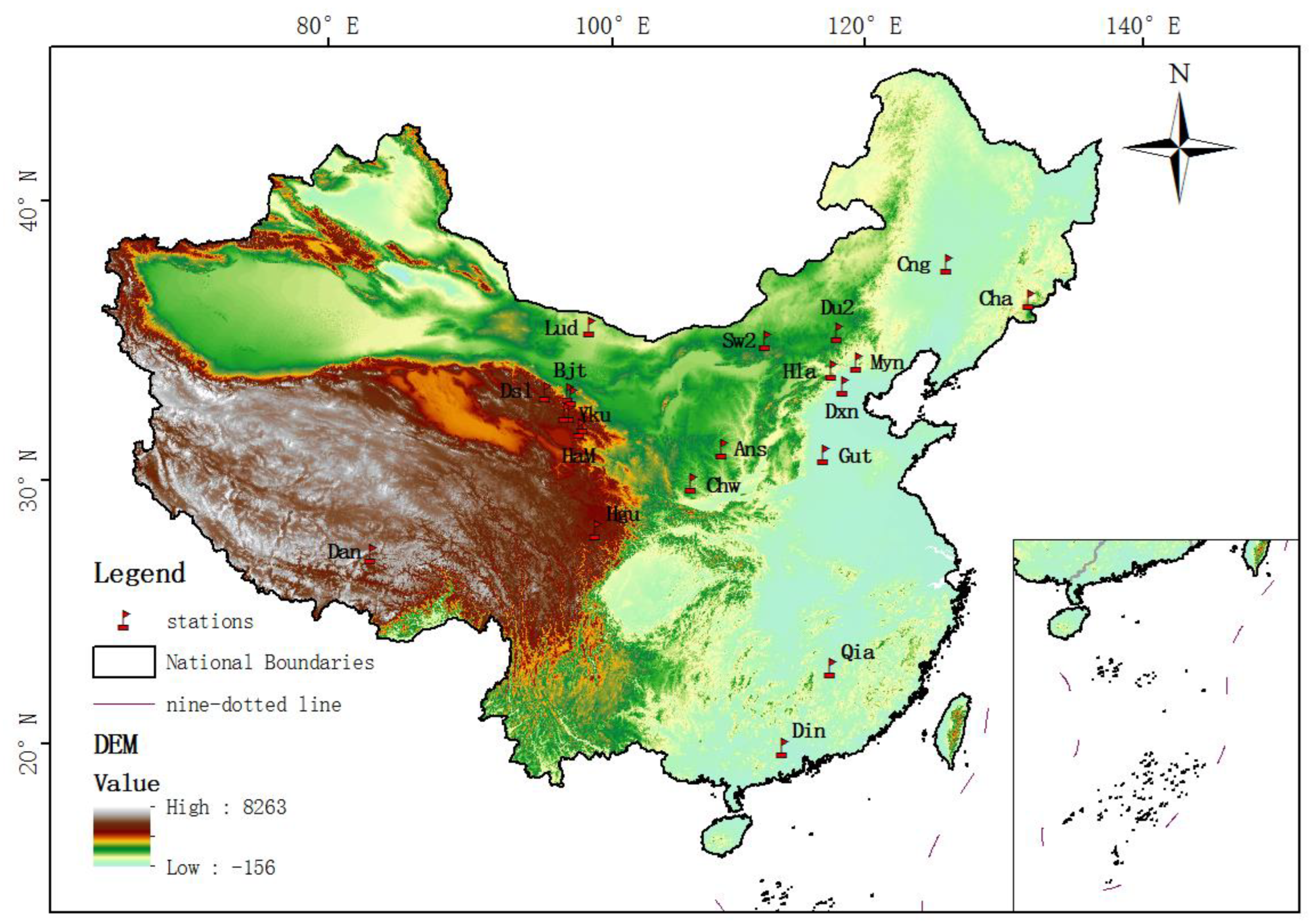
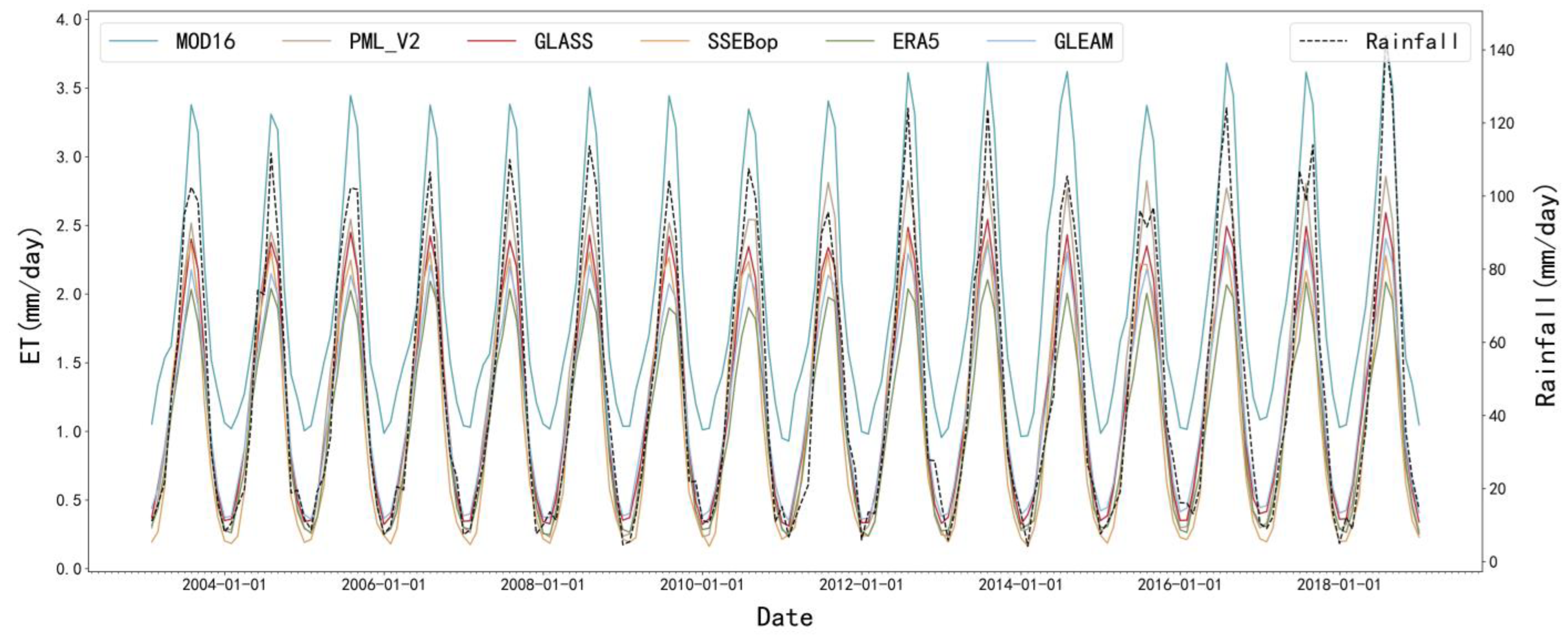

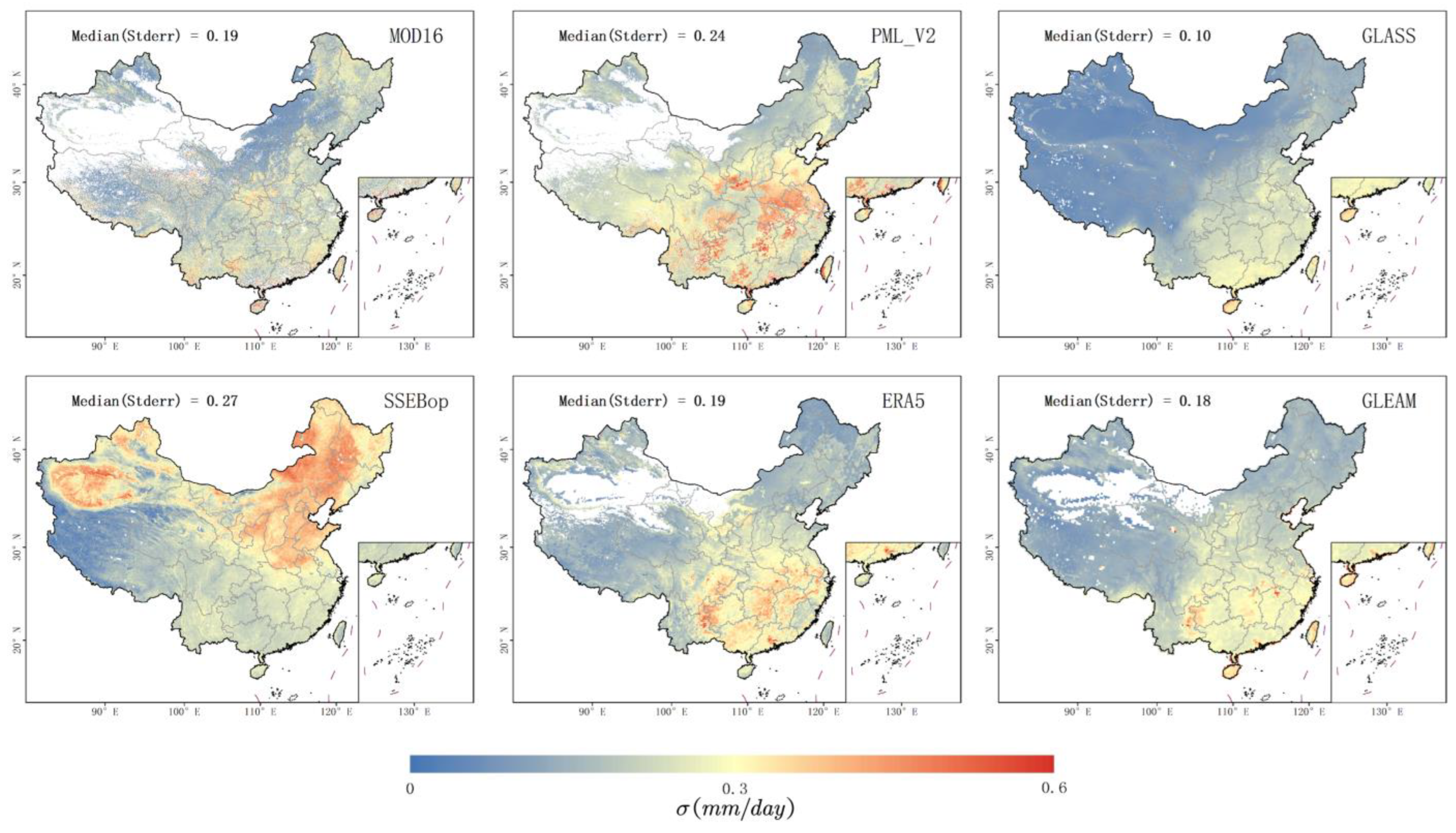

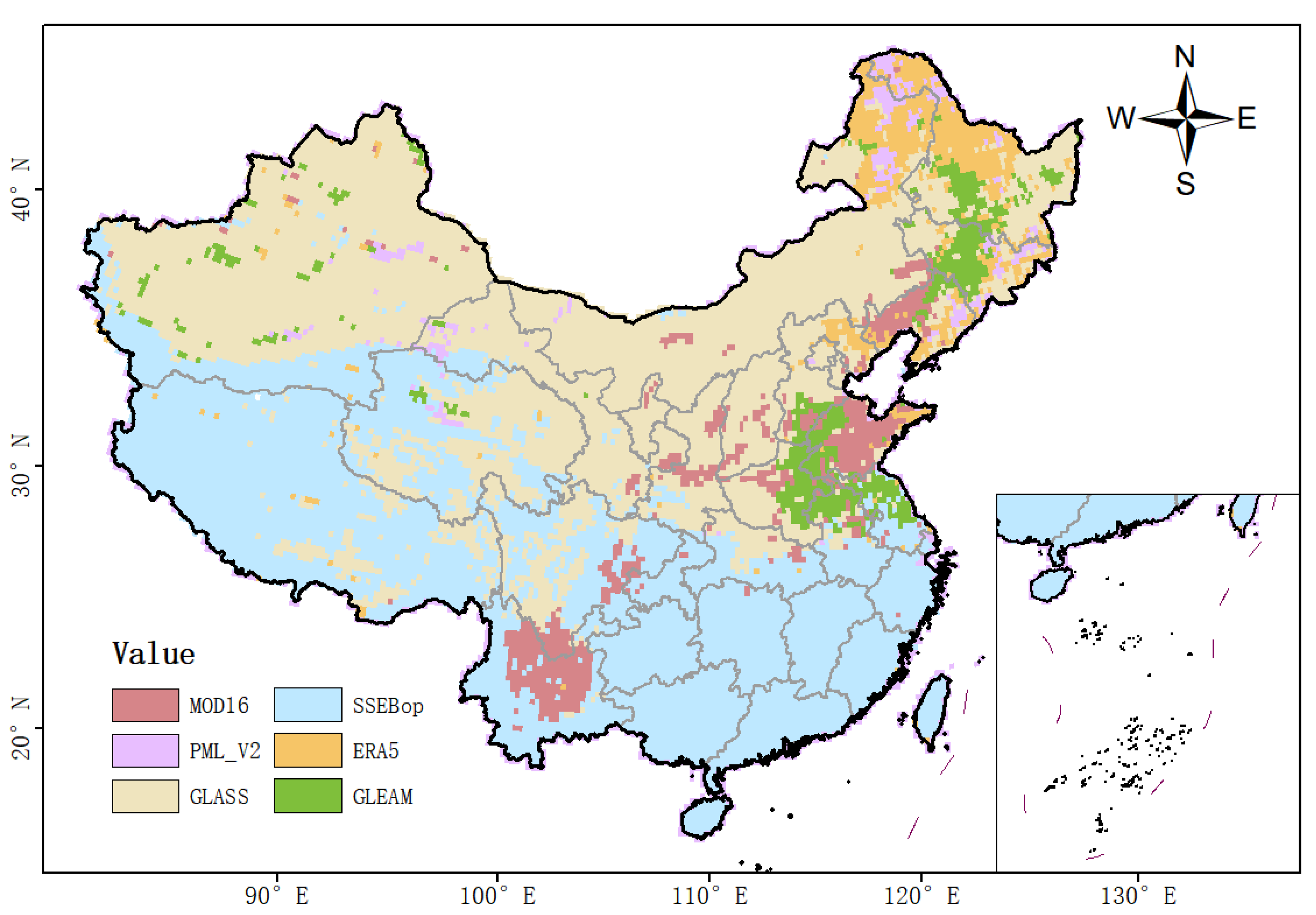
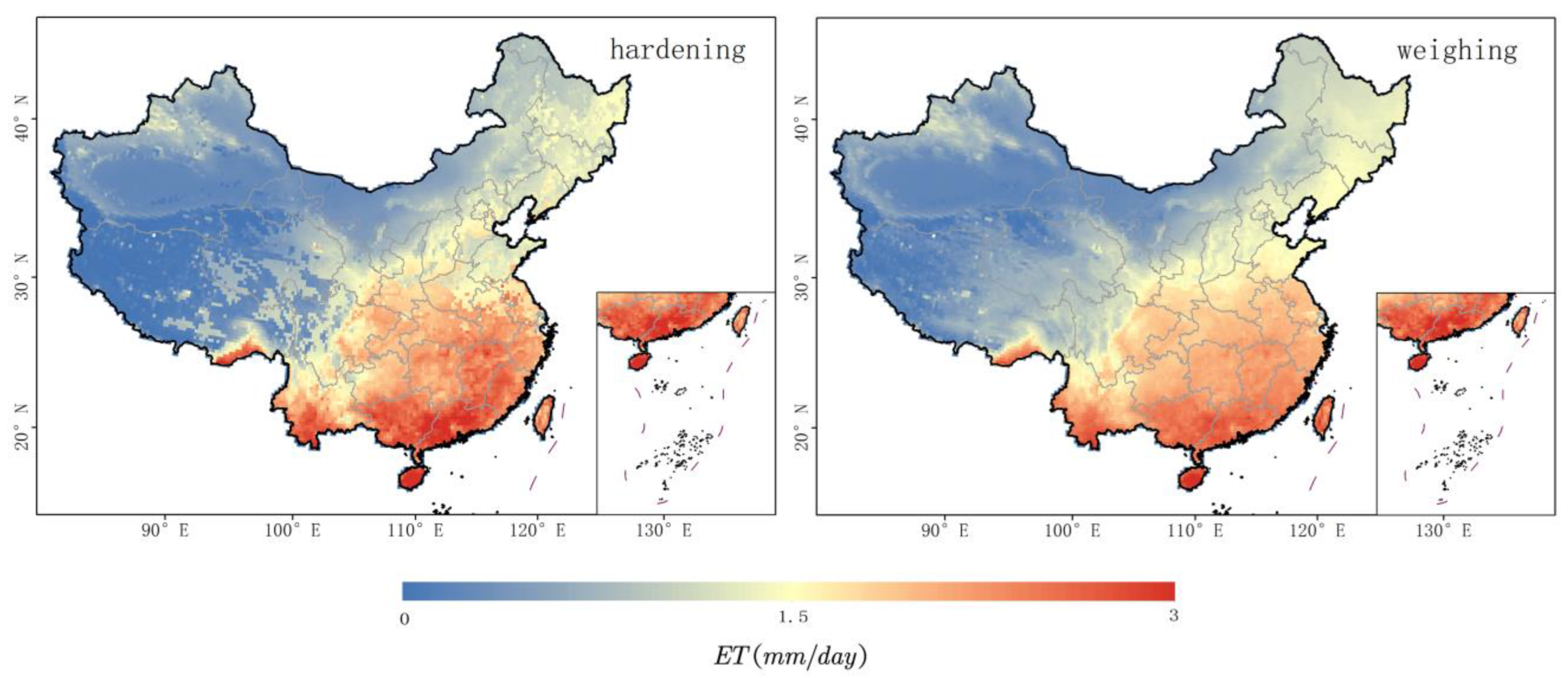
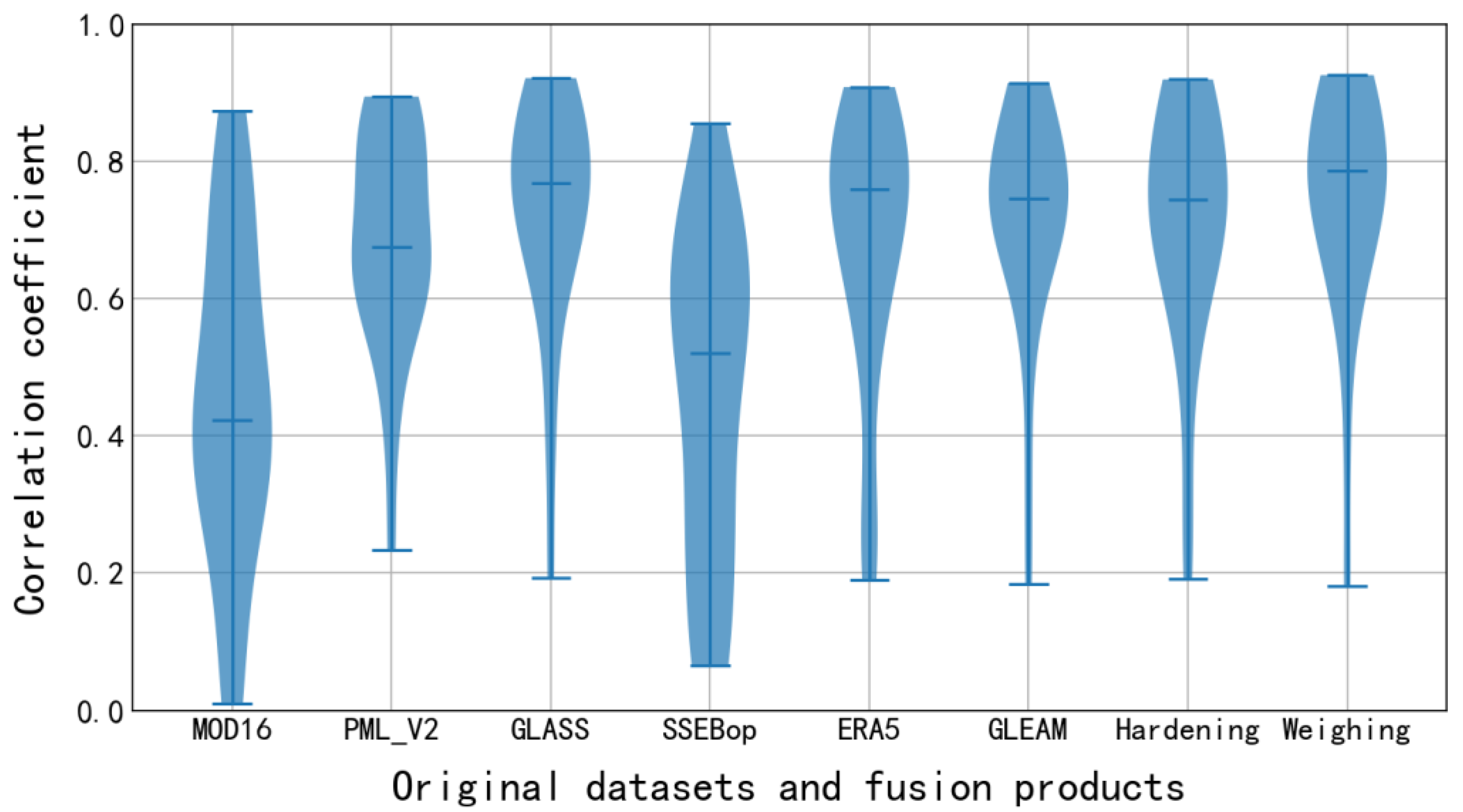
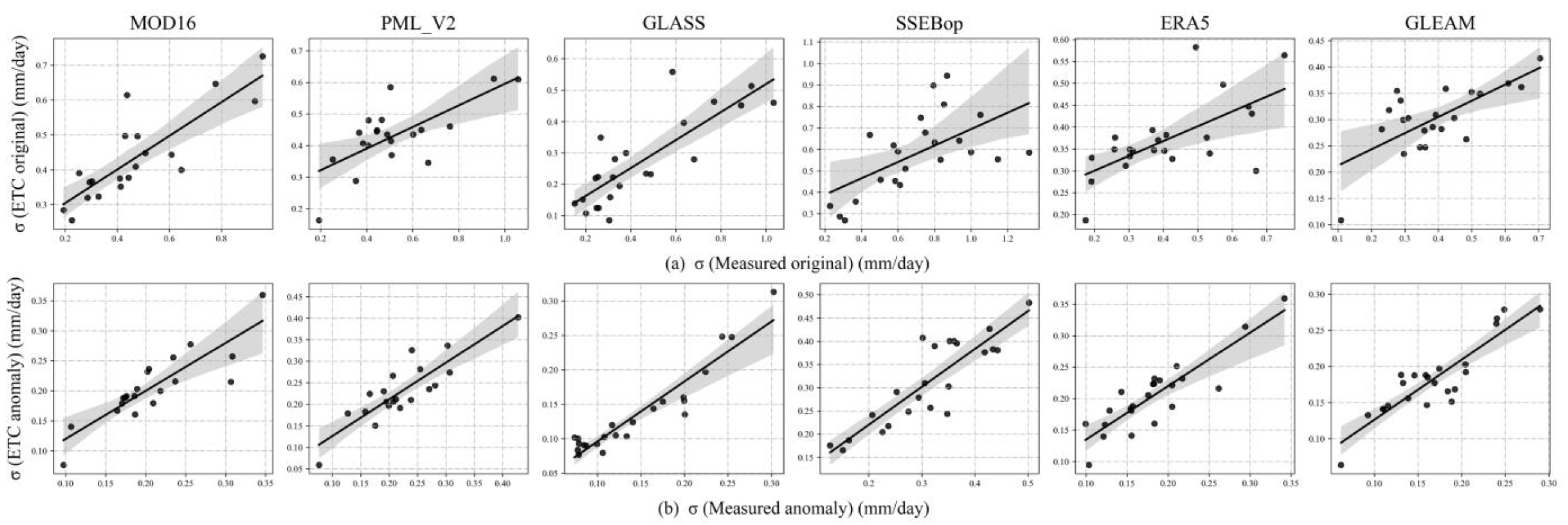
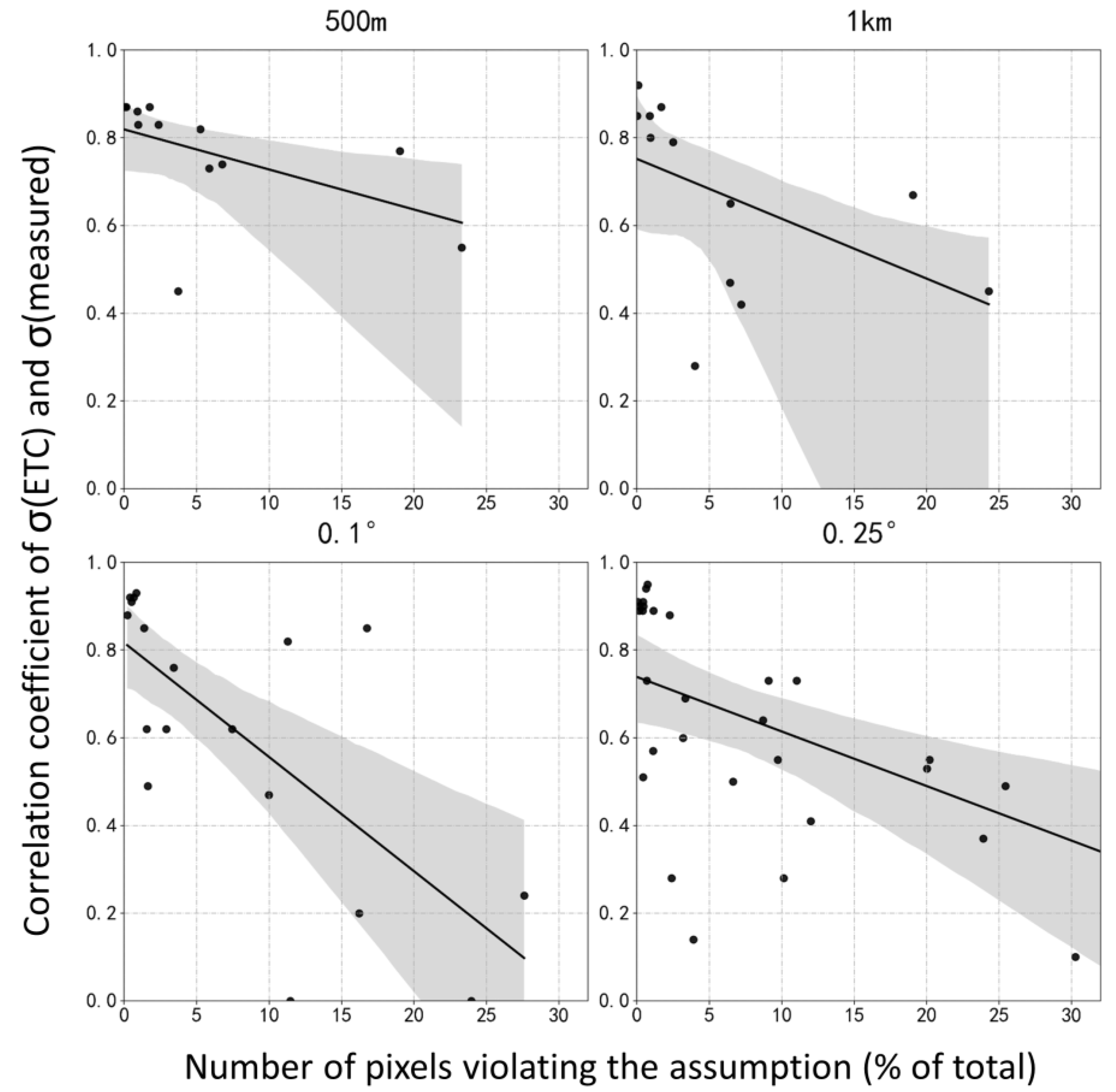
| Datasets | Scheme/Model | Spatial Resolution | Temporal Resolution | Date Range |
|---|---|---|---|---|
| MOD16A2GF | Penman–Monteith | 500 m | Every 8 days | Jan.2000–Dec.2021 |
| PML_V2 | Penman–Monteith–Leuning | 500 m | Daily | Feb.2000–Dec.2020 |
| GLASS | Bayesian model averaging | 1 km | Every 8 days | Jan.2000–Dec.2018 |
| SSEBop | surface energy balance | 1 km | Every 10 days | Jan.2003–Jun.2021 |
| ERA5 | IFS | 0.1° | Hourly | Jan.2001–present |
| GLEAM | Priestley Taylor | 0.25° | Daily | Jan.2003–Jul.2020 |
| Site | Latitude | Longitude | Type | Temporal Extent | Province | Data Source | |
|---|---|---|---|---|---|---|---|
| 1 | Cha | 42.40 | 128.10 | Forest | 2003–2005 | Jilin | Fluxnet |
| 2 | Din | 23.17 | 112.54 | Forest | 2003–2005 | Guangdong | Fluxnet |
| 3 | Qia | 26.74 | 115.06 | Forest | 2003–2005 | Fujian | Fluxnet |
| 4 | Cng | 44.59 | 123.51 | Grassland | 2007–2010 | Jilin | Fluxnet |
| 5 | Dan | 30.50 | 91.07 | Grassland | 2004–2005 | Xizang | Fluxnet |
| 6 | HaM | 37.37 | 101.18 | Grassland | 2003–2004 | Qinghai | Fluxnet |
| 7 | Hgu | 32.85 | 102.59 | Grassland | 2015–2017 | Sichuan | Fluxnet |
| 8 | Du2 | 42.05 | 116.28 | Grassland | 2006–2008 | Neimenggu | Fluxnet |
| 9 | Du3 | 42.06 | 116.28 | Grassland | 2009–2010 | Neimenggu | Fluxnet |
| 10 | Sw2 | 41.79 | 111.90 | Grassland | 2010–2012 | Neimenggu | Fluxnet |
| 11 | Aru | 38.05 | 100.46 | Grassland | 2014–2017 | Qinghai | TPDC |
| 12 | Dsl | 38.84 | 98.946 | Grassland | 2014–2017 | Qinghai | TPDC |
| 13 | Yku | 38.01 | 100.24 | Grassland | 2015–2017 | Qinghai | TPDC |
| 14 | Hla | 40.35 | 115.79 | Cropland | 2014–2017 | Hebei | TPDC |
| 15 | Myn | 40.63 | 117.32 | Cropland | 2008–2010 | Beijing | TPDC |
| 16 | Gut | 36.52 | 115.13 | Cropland | 2008–2010 | Hebei | TPDC |
| 17 | Dxn | 39.62 | 116.43 | Cropland | 2008–2010 | Beijing | TPDC |
| 18 | Chw | 35.24 | 107.68 | Cropland | 2010–2015 | Shanxi | CERN |
| 19 | Ans | 36.86 | 109.32 | Cropland | 2016–2017 | Shanxi | CERN |
| 20 | Ha2 | 37.61 | 101.33 | Wetland | 2003–2005 | Qinghai | Fluxnet |
| 21 | Ssw | 38.79 | 100.49 | Desert | 2013–2014 | Gansu | TPDC |
| 22 | Bjt | 38.91 | 100.30 | Desert | 2014–2014 | Gansu | TPDC |
| 23 | Lud | 42.00 | 101.13 | Desert | 2014–2015 | Neimenggu | TPDC |
| Triplets | MOD16 500 m | PML_V2 500 m | GLASS 1 km | SSEBop 1 km | ERA5 0.1° | GLEAM 0.25° | |
|---|---|---|---|---|---|---|---|
| 1 | MOD16-PML_V2-GLASS | 0.448 (0.23) | 0.871 (0.24) | 0.442 (0.11) | |||
| 2 | MOD16-PML_V2-GLEAM | 0.551 (0.15) | |||||
| 3 | MOD16-PML_V2-SSEBop | 0.725 (0.22) | 0.874 (0.24) | 0.799 (0.27) | |||
| 4 | MOD16-PML_V2-ERA5 | 0.062 (0.14) | |||||
| 5 | MOD16-GLASS-GLEAM | 0.893 (0.18) | |||||
| 6 | MOD16-GLASS-SSEBop | 0.821 (0.19) | 0.472 (0.13) | 0.856 (0.27) | |||
| 7 | MOD16-GLASS-ERA5 | 0.880 (0.19) | |||||
| 8 | MOD16-ERA5-GLEAM | 0.525 (0.13) | |||||
| 9 | MOD16-SSEBop-GLEAM | 0.890 (0.17) | |||||
| 10 | MOD16-SSEBop-ERA5 | 0.850 (0.19) | |||||
| 11 | PML_V2-GLASS-GLEAM | 0.380 (0.12) | |||||
| 12 | PML_V2-GLASS-SSEBop | 0.829 (0.20) | 0.668 (0.10) | 0.854 (0.26) | |||
| 13 | PML_V2-GLASS-ERA5 | 0.204 (0.12) | |||||
| 14 | PML_V2-SSEBop-GLEAM | 0.660 (0.13) | |||||
| 15 | PML_V2-ERA5-GLEAM | 0.502 (0.11) | |||||
| 16 | PML_V2-SSEBop-ERA5 | 0.000 (0.14) | |||||
| 17 | GLASS-SSEBop-GLEAM | 0.691 (0.14) | |||||
| 18 | GLASS-ERA5-GLEAM | 0.730 (0.11) | |||||
| 19 | GLASS-SSEBop-ERA5 | 0.759 (0.17) | |||||
| 20 | SSEBop-ERA5-GLEAM | 0.486 (0.12) | |||||
| MOD16 | PML_V2 | GLASS | SSEBop | ERA5 | GLEAM | |
|---|---|---|---|---|---|---|
| Regression | y = 0.75x + 0.01 | y = 0.87x + 0.04 | y = 0.63x + 0.01 | y = 0.84x + 0.05 | y = 0.85x + 0.05 | y = 0.83x + 0.04 |
| r | 0.82 | 0.87 | 0.67 | 0.86 | 0.88 | 0.89 |
| F-statistic | 33.10 | 55.22 | 14.50 | 72.35 | 72.01 | 82.36 |
| p-value | 2.97 × 10−5 (***) | 9.82 × 10−7 (***) | 0.00129 (**) | 4.46 × 10−8 (***) | 3.16 × 10−8 (***) | 1.03 × 10−8 (***) |
| RMSE | 0.05 | 0.04 | 0.05 | 0.05 | 0.04 | 0.03 |
| ET Products | “High–High” | “High–Low” | Kolmogorov–Smirnov Test | |||
|---|---|---|---|---|---|---|
| Mean | STD | Mean | STD | Statistic | p-Value | |
| MOD16 (500 m) | 0.033 | 0.231 | 0.045 | 0.208 | 0.046 | 0.000 (***) |
| PML_V2 (500 m) | 0.007 | 0.122 | 0.022 | 0.147 | 0.079 | 0.000 (***) |
| GLASS (1 km) | 0.006 | 0.237 | 0.027 | 0.359 | 0.055 | 0.000 (***) |
| SSEBop (1 km) | 0.003 | 0.047 | 0.004 | 0.101 | 0.059 | 0.000 (***) |
| ERA5 (0.1°) | 0.003 | 0.046 | 0.046 | 0.199 | 0.137 | 0.000 (***) |
| GLEAM (0.25°) | 0.001 | 0.042 | 0.054 | 0.229 | 0.270 | 0.000 (***) |
Disclaimer/Publisher’s Note: The statements, opinions and data contained in all publications are solely those of the individual author(s) and contributor(s) and not of MDPI and/or the editor(s). MDPI and/or the editor(s) disclaim responsibility for any injury to people or property resulting from any ideas, methods, instructions or products referred to in the content. |
© 2023 by the authors. Licensee MDPI, Basel, Switzerland. This article is an open access article distributed under the terms and conditions of the Creative Commons Attribution (CC BY) license (https://creativecommons.org/licenses/by/4.0/).
Share and Cite
He, Y.; Wang, C.; Hu, J.; Mao, H.; Duan, Z.; Qu, C.; Li, R.; Wang, M.; Song, X. Discovering Optimal Triplets for Assessing the Uncertainties of Satellite-Derived Evapotranspiration Products. Remote Sens. 2023, 15, 3215. https://doi.org/10.3390/rs15133215
He Y, Wang C, Hu J, Mao H, Duan Z, Qu C, Li R, Wang M, Song X. Discovering Optimal Triplets for Assessing the Uncertainties of Satellite-Derived Evapotranspiration Products. Remote Sensing. 2023; 15(13):3215. https://doi.org/10.3390/rs15133215
Chicago/Turabian StyleHe, Yan, Chen Wang, Jinghao Hu, Huihui Mao, Zheng Duan, Cixiao Qu, Runkui Li, Mingyu Wang, and Xianfeng Song. 2023. "Discovering Optimal Triplets for Assessing the Uncertainties of Satellite-Derived Evapotranspiration Products" Remote Sensing 15, no. 13: 3215. https://doi.org/10.3390/rs15133215
APA StyleHe, Y., Wang, C., Hu, J., Mao, H., Duan, Z., Qu, C., Li, R., Wang, M., & Song, X. (2023). Discovering Optimal Triplets for Assessing the Uncertainties of Satellite-Derived Evapotranspiration Products. Remote Sensing, 15(13), 3215. https://doi.org/10.3390/rs15133215









